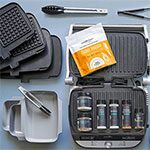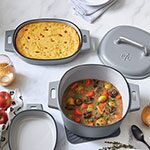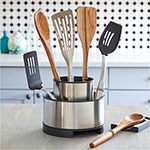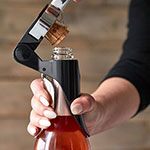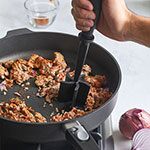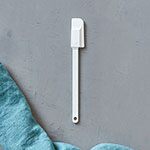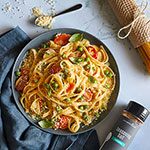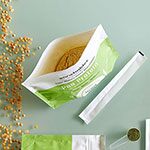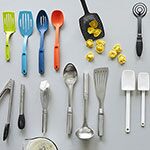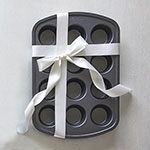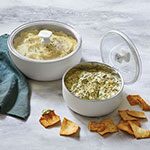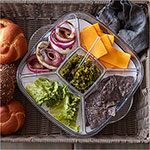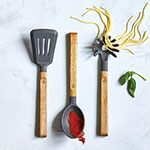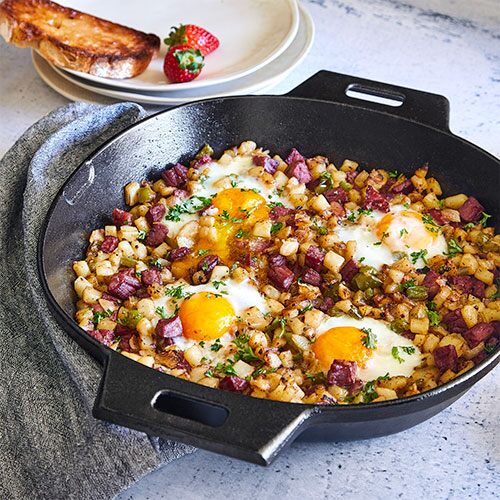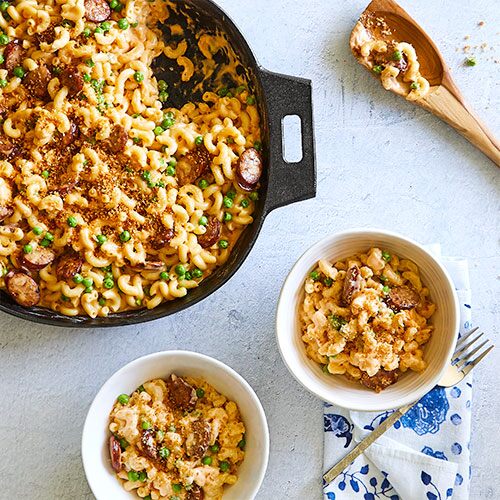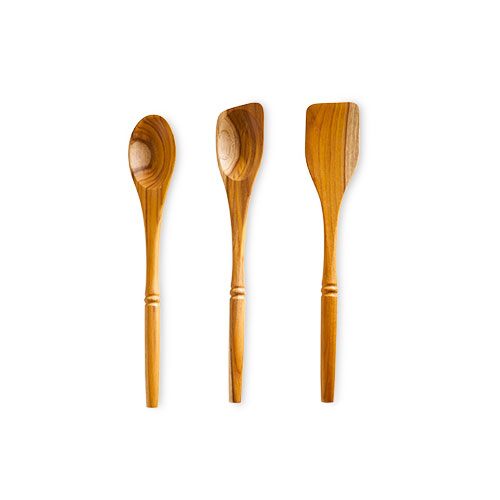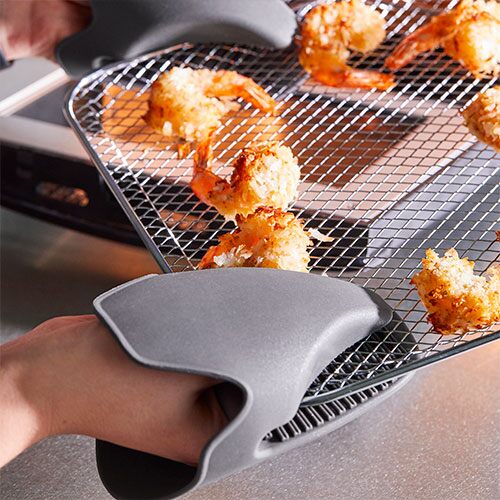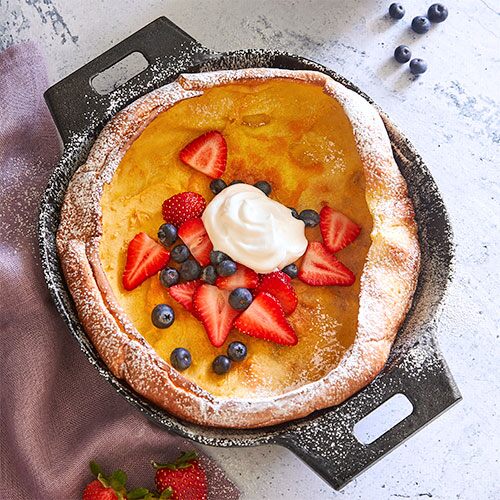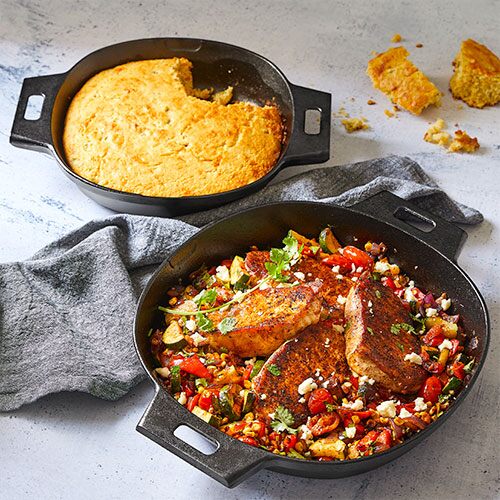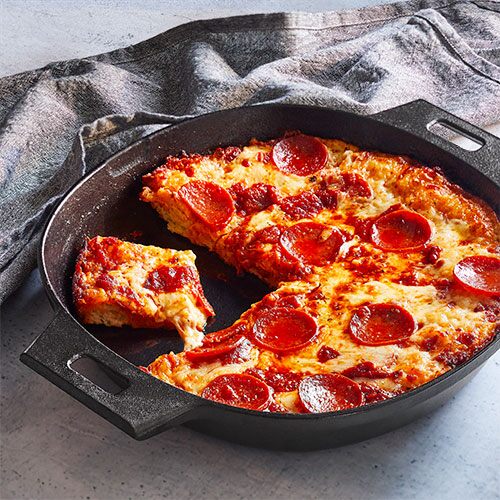12" Cast Iron Skillet
Cast Iron Cookware Is Meant To Be Loved
New! Cast iron is a cornerstone of cooking and has a well-deserved place in modern kitchens. It’s meant to be used often, loved forever, and passed down through generations.
Our 12" skillet comes preseasoned, so you can start using it right away on most heat sources. And its natural, nonstick surface gets better and better the more you use it.
Cast iron’s excellent heat retention means that food stays hot and delicious even if not everyone makes it to the table as soon as dinner’s ready. It’s heat-safe up to 650°F, so it holds up to frying, broiling, grilling, and even campfire cooking. There’s no need to be gentle, metal tools won’t damage it, either.
Reach for this pan when you need a perfect sear on steaks or a golden, crispy crust on baked treats. Our skillet has a one-of-a-kind shape that gives you more cooking area—enough to fit four chicken breasts at one time. No need to cook in batches to feed your friends or family.
And, the two, low-profile pour spouts let you easily drain off pan juices whether you’re left- or right-handed. With the cooking traditions and durability of cast iron comes a certain weightiness, but not to worry, our skillet has two handles to help you lift and carry it.
Made in the USA
Product Details
- PTFE-free.
- Pan scraper included for easy cleanup.
Warranty
- Lifetime guarantee
Recommended:
-
Use & Care
Use & Care
Use & Care

SAFEGUARDS
- For use on induction, flat glass, or ceramic cooktop surfaces.
- Handle with care on stovetop surfaces.
- Do not slide the pan and always remove it from your stovetop after cooking.
- Always use a heat-resistant barrier when placing a hot cast iron on a non-heated surface.
- Consult the appliance manufacturer’s instruction manual before using for the first time.
- Do not let the pan soak in water.
- Do not use in microwave.
CLEANING
- Wash before using for the first time; hand wash only and hand dry thoroughly.
- To clean:
- Wash by hand with a nylon scrub brush and hot water. If needed, use a pan scraper to remove stuck-on bits. For stickier foods, simmer a little water in the pan. Then, use the scraper after the pan has cooled.
- Dry with a lint-free cloth or paper towel. You can prevent rusting by drying the pan thoroughly.
- While the pan is warm, rub it with a very light layer of cooking oil. This will prevent stickiness and let the seasoning build over time.
- Hang or store in a dry place.
- To remove rust:
- Scour the affected area with steel wool.
- Rinse, hand dry, and rub it with cooking oil.
- Re-season the pan by heating it up.
- If rust continues, re-season your pan.
- As you clean, you may notice some dark residue on your cloth or paper towel. This is perfectly normal and safe—it’s just seasoning (baked on cooking oil) responding to foods that may be slightly acidic or alkaline. The residue will disappear with regular use and care.
- Soap isn’t always necessary when cleaning the pan. If you like, you can use some dishwashing liquid. Stay away from dishwashers and metal scouring pads, which can harm the seasoning.
USE AND CARE
Cook With Any Combination:

The pan is heat-safe up to 650°F (340°C). When it’s empty, the seasoning will start to break down at sustained temperatures around 650°F (340°C).
- Stovetop use:
- Select a burner size that matches the diameter of the cookware base. For gas stoves, flames should not extend beyond base of cookware.
- Do not slide, spin, or drag the pan over the surface of your stovetop, especially glass top ranges, as scratches may result and are not covered by the product guarantee.
- Utensils: The pan is safe for metal utensils.
- Seasoning tips:
- While the pan comes preseasoned, the best way to maintain the seasoning is to use your pan.
- You can keep your pan in great condition by regularly cooking with it and lightly coating it in cooking oil.
- Seasoning, which is oil baked onto the cast iron, gives it a natural, easy-release finish.
- You can use any food-safe shortening or cooking oil like vegetable or canola oil.
- If your pan becomes dull, gray, splotchy, or rusted, you should re-season it.
- Foods that are acidic (i.e. beans, tomatoes, citrus, etc.) shouldn’t be cooked in seasoned cast iron until the pan is highly seasoned.
- The high acidity in these foods will strip the seasoning and result in pan discoloration and metallic-tasting food.
- Wait until the pan is seasoned to cook these kinds of foods.
- Note: This also applies to boiling, which can break down seasoning.
- If the surface of your pan becomes sticky, excess oil is building up and not fully converting to seasoning.
- You can fix it by placing the pan in the oven upside down on the top rack and baking it at 450°F (230°C) for 1 hour.
- Let the pan cool and repeat if necessary.
- How to re-season your cast iron pan:
- Wash in warm water and towel dry.
- Using a clean cloth or paper towel, thoroughly rub cooking oil inside the pan. Continue until there is no longer a greasy sheen. This is important so oil doesn’t pool during the seasoning process and form into hardened droplets or turn sticky if the pan isn’t used for a few days.
- Put the oiled pan upside down in a preheated 450°F (230°C) for one hour. Place a sheet pan on the rack below.
- Remove the pan with oven mitts, then apply more oil as outlined in step 2. Place the pan back into the oven. Repeat this step 2–3 times.
- The pan may be rough in some areas. This is a result of the manufacturing process. With each use and re-seasoning, the pan will become smooth and get better over time.
- Cast iron, which has superior heat retention, performs best when heated and cooled gradually. It rarely requires a high heat setting.
Guarantee
Use & Care

SAFEGUARDS
- For use on induction, flat glass, or ceramic cooktop surfaces.
- Handle with care on stovetop surfaces.
- Do not slide the pan and always remove it from your stovetop after cooking.
- Always use a heat-resistant barrier when placing a hot cast iron on a non-heated surface.
- Consult the appliance manufacturer’s instruction manual before using for the first time.
- Do not let the pan soak in water.
- Do not use in microwave.
CLEANING
- Wash before using for the first time; hand wash only and hand dry thoroughly.
- To clean:
- Wash by hand with a nylon scrub brush and hot water. If needed, use a pan scraper to remove stuck-on bits. For stickier foods, simmer a little water in the pan. Then, use the scraper after the pan has cooled.
- Dry with a lint-free cloth or paper towel. You can prevent rusting by drying the pan thoroughly.
- While the pan is warm, rub it with a very light layer of cooking oil. This will prevent stickiness and let the seasoning build over time.
- Hang or store in a dry place.
- To remove rust:
- Scour the affected area with steel wool.
- Rinse, hand dry, and rub it with cooking oil.
- Re-season the pan by heating it up.
- If rust continues, re-season your pan.
- As you clean, you may notice some dark residue on your cloth or paper towel. This is perfectly normal and safe—it’s just seasoning (baked on cooking oil) responding to foods that may be slightly acidic or alkaline. The residue will disappear with regular use and care.
- Soap isn’t always necessary when cleaning the pan. If you like, you can use some dishwashing liquid. Stay away from dishwashers and metal scouring pads, which can harm the seasoning.
USE AND CARE
Cook With Any Combination:

The pan is heat-safe up to 650°F (340°C). When it’s empty, the seasoning will start to break down at sustained temperatures around 650°F (340°C).
- Stovetop use:
- Select a burner size that matches the diameter of the cookware base. For gas stoves, flames should not extend beyond base of cookware.
- Do not slide, spin, or drag the pan over the surface of your stovetop, especially glass top ranges, as scratches may result and are not covered by the product guarantee.
- Utensils: The pan is safe for metal utensils.
- Seasoning tips:
- While the pan comes preseasoned, the best way to maintain the seasoning is to use your pan.
- You can keep your pan in great condition by regularly cooking with it and lightly coating it in cooking oil.
- Seasoning, which is oil baked onto the cast iron, gives it a natural, easy-release finish.
- You can use any food-safe shortening or cooking oil like vegetable or canola oil.
- If your pan becomes dull, gray, splotchy, or rusted, you should re-season it.
- Foods that are acidic (i.e. beans, tomatoes, citrus, etc.) shouldn’t be cooked in seasoned cast iron until the pan is highly seasoned.
- The high acidity in these foods will strip the seasoning and result in pan discoloration and metallic-tasting food.
- Wait until the pan is seasoned to cook these kinds of foods.
- Note: This also applies to boiling, which can break down seasoning.
- If the surface of your pan becomes sticky, excess oil is building up and not fully converting to seasoning.
- You can fix it by placing the pan in the oven upside down on the top rack and baking it at 450°F (230°C) for 1 hour.
- Let the pan cool and repeat if necessary.
- How to re-season your cast iron pan:
- Wash in warm water and towel dry.
- Using a clean cloth or paper towel, thoroughly rub cooking oil inside the pan. Continue until there is no longer a greasy sheen. This is important so oil doesn’t pool during the seasoning process and form into hardened droplets or turn sticky if the pan isn’t used for a few days.
- Put the oiled pan upside down in a preheated 450°F (230°C) for one hour. Place a sheet pan on the rack below.
- Remove the pan with oven mitts, then apply more oil as outlined in step 2. Place the pan back into the oven. Repeat this step 2–3 times.
- The pan may be rough in some areas. This is a result of the manufacturing process. With each use and re-seasoning, the pan will become smooth and get better over time.
- Cast iron, which has superior heat retention, performs best when heated and cooled gradually. It rarely requires a high heat setting.
Guarantee
- For use on induction, flat glass, or ceramic cooktop surfaces.


 Canada (en)
Canada (en) Germany (de)
Germany (de) Austria (de)
Austria (de)